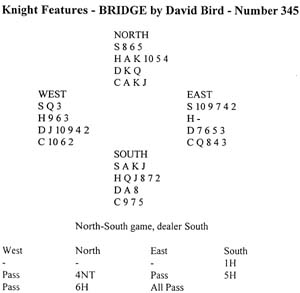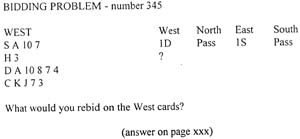|
Bridge
David Bird
 THE
north hand is difficult to bid without scientific methods. The sequence
was unsatisfactory because it made no attempt to identify a grand slam.
There was nothing wrong with the final contract of 6H. How would you
play it when West leads the jack of diamonds and East shows out on the
first round of trumps? It may seem that the slam will need one of the
black queens to be onside. You can achieve a small extra chance by
eliminating the red suits and playing one of the black suits from the
top — the ace and king followed by the jack. Nothing is lost if the
finesse was onside because the defender who wins the third round with
the queen will be end-played. The extra chance is that you may drop a
doubleton queen offside. You can attempt this play in just one of the
black suits, so you must calculate who is more likely to hold a
doubleton black queen. Since West started with three trumps to his
partner’s none, he is more likely to be short in a black suit. After
drawing trumps and eliminating the diamonds, you should therefore play
the ace, king and jack of spades. When the cards lie as in the diagram
you will deserve a ‘Well played, partner!’ THE
north hand is difficult to bid without scientific methods. The sequence
was unsatisfactory because it made no attempt to identify a grand slam.
There was nothing wrong with the final contract of 6H. How would you
play it when West leads the jack of diamonds and East shows out on the
first round of trumps? It may seem that the slam will need one of the
black queens to be onside. You can achieve a small extra chance by
eliminating the red suits and playing one of the black suits from the
top — the ace and king followed by the jack. Nothing is lost if the
finesse was onside because the defender who wins the third round with
the queen will be end-played. The extra chance is that you may drop a
doubleton queen offside. You can attempt this play in just one of the
black suits, so you must calculate who is more likely to hold a
doubleton black queen. Since West started with three trumps to his
partner’s none, he is more likely to be short in a black suit. After
drawing trumps and eliminating the diamonds, you should therefore play
the ace, king and jack of spades. When the cards lie as in the diagram
you will deserve a ‘Well played, partner!’
 Answer
to Bidding Problem Answer
to Bidding Problem
Answer
With three-card support
and a ruffing value you should raise to 2S. You will hear players say
‘I always have four card support for a raise.’ Expert opinion is
almost unanimous, however, that it is best to raise the spades on this
type of hand. With the same shape and nearer to 16 points, you would
rebid 2C and then bid 2S over a correction to 2D. Here you are minimum
and not intending to bid again unless partner forces you to. You should
look for the most descriptive rebid.
Awards: 2S-10, 2C-7,
2D-3.
— Knight Features
|